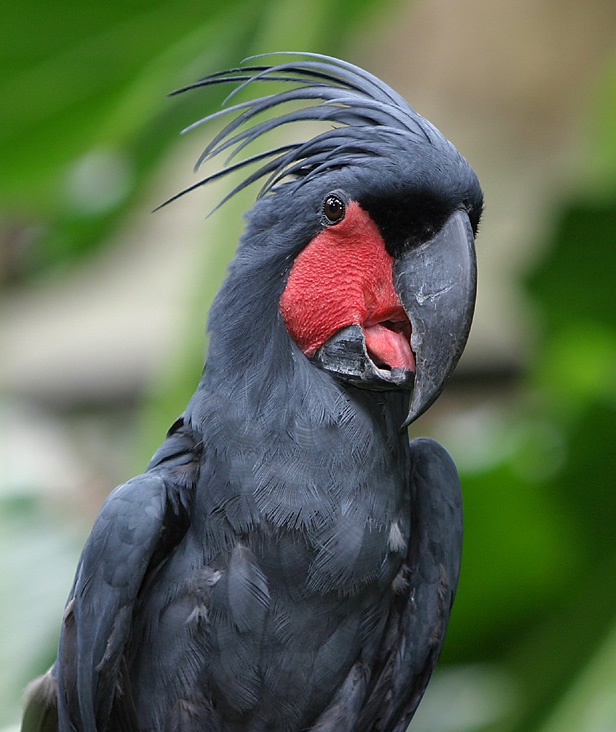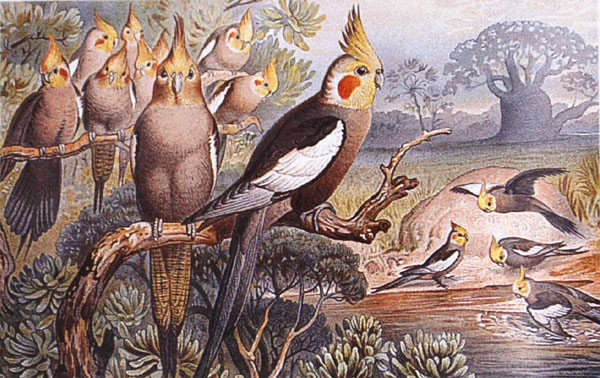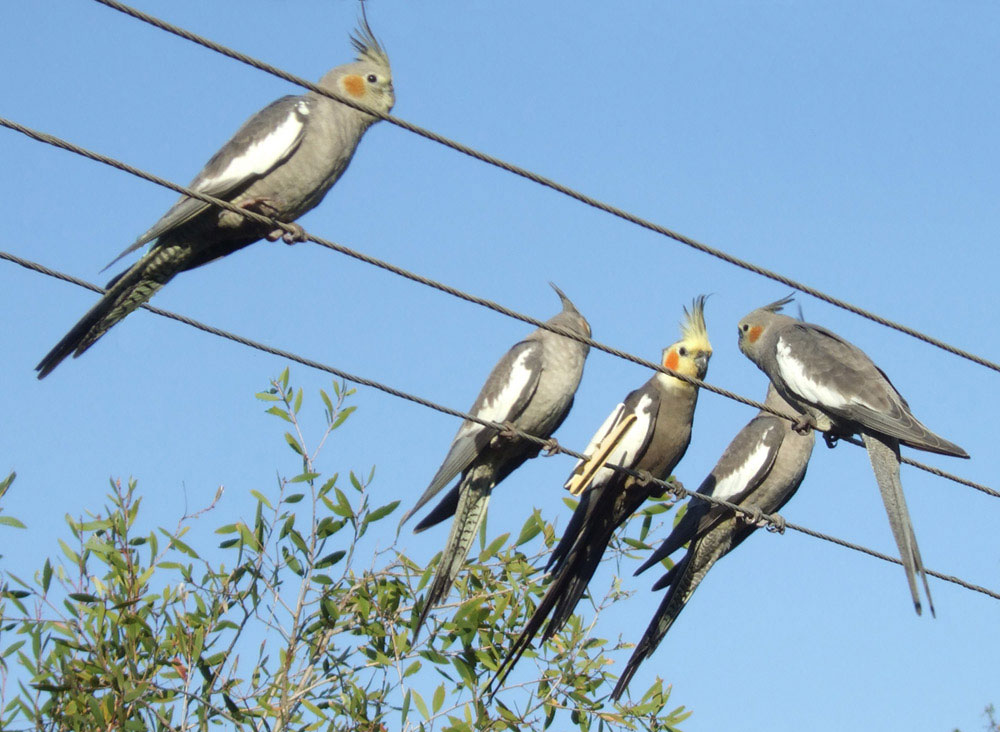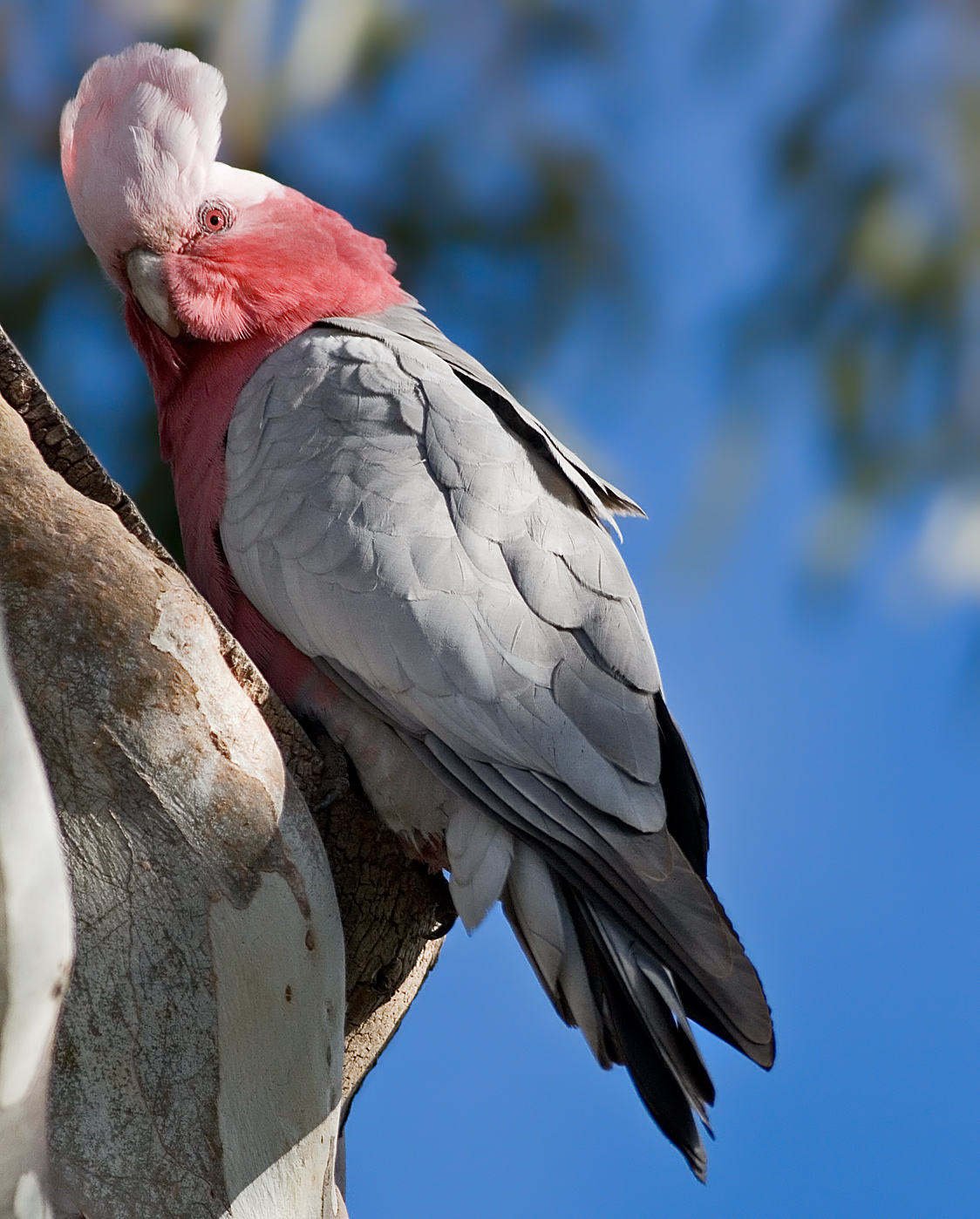|
Cockatoos
A cockatoo is any of the 21 parrot species belonging to the family Cacatuidae, the only family in the superfamily Cacatuoidea. Along with the Psittacoidea (true parrots) and the Strigopoidea (large New Zealand parrots), they make up the order Psittaciformes. The family has a mainly Australasian distribution, ranging from the Philippines and the eastern Indonesian islands of Wallacea to New Guinea, the Solomon Islands and Australia. Cockatoos are recognisable by the prominent crests and curved bills. Their plumage is generally less colourful than that of other parrots, being mainly white, grey or black and often with coloured features in the crest, cheeks or tail. On average they are larger than other parrots; however, the cockatiel, the smallest cockatoo species, is a small bird. The phylogenetic position of the cockatiel remains unresolved, other than that it is one of the earliest offshoots of the cockatoo lineage. The remaining species are in two main clades. The five ... [...More Info...] [...Related Items...] OR: [Wikipedia] [Google] [Baidu] |
Cockatiel
The cockatiel (; ''Nymphicus hollandicus''), also known as weiro (also spelt weero), or quarrion, is a medium-sized parrot that is a member of its own branch of the cockatoo family endemic to Australia. They are prized as household pets and companion parrots throughout the world and are relatively easy to breed. As a caged bird, cockatiels are second in popularity only to the budgerigar. The cockatiel is the only member of the genus ''Nymphicus''. It was previously unclear whether the cockatiel was a crested parakeet or small cockatoo; however, more recent molecular studies have assigned it to its own subfamily, ''Nymphicinae''. It is, therefore, now classified as the smallest of the Cacatuidae (cockatoo family). Cockatiels are native to Australia, favouring the Australian wetlands, scrublands, and bushlands. Taxonomy and etymology Originally described by Scottish writer and naturalist Robert Kerr in 1793 as ''Psittacus hollandicus'', the cockatiel (or cockateel) was moved t ... [...More Info...] [...Related Items...] OR: [Wikipedia] [Google] [Baidu] |
Parrot
Parrots, also known as psittacines (), are birds of the roughly 398 species in 92 genera comprising the order Psittaciformes (), found mostly in tropical and subtropical regions. The order is subdivided into three superfamilies: the Psittacoidea ("true" parrots), the Cacatuoidea (cockatoos), and the Strigopoidea (New Zealand parrots). One-third of all parrot species are threatened by extinction, with higher aggregate extinction risk ( IUCN Red List Index) than any other comparable bird group. Parrots have a generally pantropical distribution with several species inhabiting temperate regions in the Southern Hemisphere, as well. The greatest diversity of parrots is in South America and Australasia. Characteristic features of parrots include a strong, curved bill, an upright stance, strong legs, and clawed zygodactyl feet. Many parrots are vividly coloured, and some are multi-coloured. Most parrots exhibit little or no sexual dimorphism in the visual spectrum. They form the most ... [...More Info...] [...Related Items...] OR: [Wikipedia] [Google] [Baidu] |
Nymphicus
The cockatiel (; ''Nymphicus hollandicus''), also known as weiro (also spelt weero), or quarrion, is a medium-sized parrot that is a member of its own branch of the cockatoo family endemic to Australia. They are prized as household pets and companion parrots throughout the world and are relatively easy to breed. As a caged bird, cockatiels are second in popularity only to the budgerigar. The cockatiel is the only member of the genus ''Nymphicus''. It was previously unclear whether the cockatiel was a crested parakeet or small cockatoo; however, more recent molecular studies have assigned it to its own subfamily, ''Nymphicinae''. It is, therefore, now classified as the smallest of the Cacatuidae (cockatoo family). Cockatiels are native to Australia, favouring the Australian wetlands, scrublands, and bushlands. Taxonomy and etymology Originally described by Scottish writer and naturalist Robert Kerr in 1793 as ''Psittacus hollandicus'', the cockatiel (or cockateel) was moved t ... [...More Info...] [...Related Items...] OR: [Wikipedia] [Google] [Baidu] |
Crest (feathers)
The crest is a prominent feature exhibited by several bird and other dinosaur species on their heads. It is distinct from features such as casques and cockscombs - sometimes erroneously referred to as "crests", which are bony and fleshy structures respectively. The crest is made up of semiplume feathers: a long rachis with barbs on either side. These are plumulaceous feathers, meaning that they are soft and bendable. In birds, these semiplumes are common along the head, neck, and upper back, and may be used for buoyancy and sensing vibrations. Crests on birds are generally used for display purposes. Cockatoos and their smaller cousins, cockatiels, are part of the parrot family Cacatuidae found in Australia, the Bismarck Archipelago and the Philippines, and are probably the most recognizable birds to feature crests. Cockatoos and cockatiels possess crests which may be raised or lowered at will. Their crests are used to communicate with fellow members of their species, or as a fo ... [...More Info...] [...Related Items...] OR: [Wikipedia] [Google] [Baidu] |
Probosciger
The palm cockatoo (''Probosciger aterrimus''), also known as the goliath cockatoo or great black cockatoo, is a large smoky-grey or black parrot of the cockatoo family native to New Guinea, Aru Islands, and Cape York Peninsula. It has a very large black beak and prominent red cheek patches. Taxonomy The palm cockatoo was originally described by German naturalist Johann Friedrich Gmelin in 1788 as ''Psittacus aterrimus''. Its specific name, ''Probosciger aterrimus'', is from Latin ''proboscis'', long thin nose + ''-ger'', carry, and Latin superlative adjective for ''ater'', black, hence a "black irdwith a long thin nose (beak)". The only member of the monotypic genus, ''Probosciger'', the palm cockatoo is a member of the white cockatoo subfamily Cacatuinae. Earlier limited genetic studies found it to be the earliest offshoot from the ancestors of what have become the cockatoo family. Four subspecies are recognized, three poorly differentiated and one distinctive. The Cape Yo ... [...More Info...] [...Related Items...] OR: [Wikipedia] [Google] [Baidu] |
Calyptorhynchus
Described by French naturalist Anselme Gaëtan Desmarest in 1826, the genus ''Calyptorhynchus'' has two species of cockatoos. They are all mostly black in colour, and the taxa may be differentiated partly by size and partly by small areas of red, grey, and yellow plumage, especially in the tail feathers. Studies based on the mitochondrial DNA 12S gene fragment suggested that other sexually dichromatic species, the gang-gang cockatoo and the cockatiel may be the closest living relatives of ''Calyptorhynchus''. However, subsequent studies, including more genes confirm the morphological taxonomy with the gang-gang cockatoo most closely related to the galah, within the white cockatoo group, and with the cockatiel as a third distinct subfamily of cockatoos. The Yellow-tailed black cockatoo, Baudin's black cockatoo and Carnaby's black cockatoo Carnaby's black cockatoo (''Zanda latirostris''), also known as the short-billed black cockatoo, is a large black cockatoo endemic to s ... [...More Info...] [...Related Items...] OR: [Wikipedia] [Google] [Baidu] |
Zanda (bird)
The genus ''Zanda'' has three species of cockatoos. They are all mostly black in colour, and the taxa may be differentiated partly by size and partly by small areas of red, grey, and yellow plumage, especially in the tail feathers. The genus ''Zanda'' was introduced in 1913 by the Australian born ornithologist Gregory Mathews with Baudin's black cockatoo as the type species In zoological nomenclature, a type species (''species typica'') is the species name with which the name of a genus or subgenus is considered to be permanently taxonomically associated, i.e., the species that contains the biological type specimen .... Matthews provided no explanation for the etymology but it is possibly an aboriginal name. Species The genus contains three species. References Further reading * * {{Authority control Bird genera ... [...More Info...] [...Related Items...] OR: [Wikipedia] [Google] [Baidu] |
Eolophus
The galah (; ''Eolophus roseicapilla''), also known as the pink and grey cockatoo or rose-breasted cockatoo, is the only species within genus ''Eolophus'' of the cockatoo family. Found throughout Australia, it is among the most common of the cockatoos. With its distinctive pink and grey plumage and its bold and loud behaviour, it is a familiar sight in the wild and increasingly in urban areas. It has benefited from the change in the landscape since European colonisation, and appears to be replacing the Major Mitchell's cockatoo in parts of its range. Etymology The term galah is derived from ''gilaa'', a word from the Yuwaalaraay and neighbouring Aboriginal languages spoken in north-western New South Wales. Description The galah is about in length, and weighs . It has a pale silver to grey back, a pale grey rump, a pink face and breast, and a light pink mobile crest. It has a bone-coloured beak, and the bare skin of the eye ring is carunculated. It has grey legs. The sexes a ... [...More Info...] [...Related Items...] OR: [Wikipedia] [Google] [Baidu] |
Galah
The galah (; ''Eolophus roseicapilla''), also known as the pink and grey cockatoo or rose-breasted cockatoo, is the only species within genus ''Eolophus'' of the cockatoo family. Found throughout Australia, it is among the most common of the cockatoos. With its distinctive pink and grey plumage and its bold and loud behaviour, it is a familiar sight in the wild and increasingly in urban areas. It has benefited from the change in the landscape since European colonisation, and appears to be replacing the Major Mitchell's cockatoo in parts of its range. Etymology The term galah is derived from ''gilaa'', a word from the Yuwaalaraay and neighbouring Aboriginal languages spoken in north-western New South Wales. Description The galah is about in length, and weighs . It has a pale silver to grey back, a pale grey rump, a pink face and breast, and a light pink mobile crest. It has a bone-coloured beak, and the bare skin of the eye ring is carunculated. It has grey legs. The sexes a ... [...More Info...] [...Related Items...] OR: [Wikipedia] [Google] [Baidu] |
Beak
The beak, bill, or rostrum is an external anatomical structure found mostly in birds, but also in turtles, non-avian dinosaurs and a few mammals. A beak is used for eating, preening, manipulating objects, killing prey, fighting, probing for food, courtship, and feeding young. The terms ''beak'' and ''rostrum'' are also used to refer to a similar mouth part in some ornithischians, pterosaurs, cetaceans, dicynodonts, anuran tadpoles, monotremes (i.e. echidnas and platypuses, which have a beak-like structure), sirens, pufferfish, billfishes and cephalopods. Although beaks vary significantly in size, shape, color and texture, they share a similar underlying structure. Two bony projections – the upper and lower mandibles – are covered with a thin keratinized layer of epidermis known as the rhamphotheca. In most species, two holes called ''nares'' lead to the respiratory system. Etymology Although the word "beak" was, in the past, generally restricted to the sharpened bills o ... [...More Info...] [...Related Items...] OR: [Wikipedia] [Google] [Baidu] |
Kaka (bird)
The genus ''Nestor'' is the type and only extant genus of the parrot family Nestoridae. Together with the kākāpō, and the extinct parrots in the genus '' Nelepsittacus'', they form the parrot superfamily Strigopoidea. The genus ''Nestor'' contains two extant parrot species from New Zealand and two extinct species from Norfolk Island, Australia and Chatham Island, New Zealand, respectively. All species are large stocky birds with short squarish tails. A defining characteristic of the genus is the tongue, which is tipped with a hair-like fringe. The superficial resemblance of this tongue to that of lorikeets has led some taxonomists to consider the two groups closely related, but DNA evidence shows they are not. Classification All four species in the genus ''Nestor'' are thought to stem from a 'proto-kākā', dwelling in the forests of New Zealand 5 million years ago. The closest living relative of the genus is the kākāpō (''Strigops habroptilus'').de Kloet, R.S.; de Kloet, S. ... [...More Info...] [...Related Items...] OR: [Wikipedia] [Google] [Baidu] |
Australia
Australia, officially the Commonwealth of Australia, is a Sovereign state, sovereign country comprising the mainland of the Australia (continent), Australian continent, the island of Tasmania, and numerous List of islands of Australia, smaller islands. With an area of , Australia is the largest country by area in Oceania and the world's List of countries and dependencies by area, sixth-largest country. Australia is the oldest, flattest, and driest inhabited continent, with the least fertile soils. It is a Megadiverse countries, megadiverse country, and its size gives it a wide variety of landscapes and climates, with Deserts of Australia, deserts in the centre, tropical Forests of Australia, rainforests in the north-east, and List of mountains in Australia, mountain ranges in the south-east. The ancestors of Aboriginal Australians began arriving from south east Asia approximately Early human migrations#Nearby Oceania, 65,000 years ago, during the Last Glacial Period, last i ... [...More Info...] [...Related Items...] OR: [Wikipedia] [Google] [Baidu] |





-8-2cp.jpg)


_-on_ground-8.jpg)